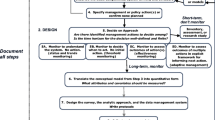Abstract
Guidelines for the early stages of developing a monitoring program are presented. Jumping right into a monitoring program based on standard protocols and a number of commonly monitored parameters is an attractive idea, but it is unlikely to lead to an intelligent allocation of time and money. Rather, a number of well-defined planning steps must be followed before monitoring is begun:
-
1.
Objectives for the program should be well defined.
-
2.
The attributes to be monitored in order to meet objectives should be listed.
-
3.
Methods of monitoring these attributes should be developed.
-
4.
A pilot study should be conducted to determine spatial and temporal variability of the attributes being monitored and the cost of sampling.
-
5.
The results of the pilot study should be carefully evaluated to determine whether program objectives can be met for an acceptable cost.
-
6.
Objectives, attributes to be monitored, and methods should be revised in accordance with the results of the pilot study.
Similar content being viewed by others
References
Buttrick, Steven C.: 1984, ‘Biological Monitoring: The Nature Conservancy's Perspective’, pp. 59–63, in: Janet L. Johnson, Jerry F. Franklin and Richard G. Krebill (coordinators), Research Natural Areas: Baseline Monitoring and Management: Proceedings of a Symposium, March 21, 1984, Missoula MT. Gen. Tech Rept INT 173. Ogden, UT. USDA Forest Service Intermountain Forest and Range Experiment Station, 84 pp.
Croze, Harvey: 1982, ‘Monitoring Within and Outside Protected Areas’, pp. 628–633, in: Jeffrey A. McNeely and Kenton R. Miller (Eds.), National Parks, Conservation, and Development: The Role of Protected Areas in Sustaining Society. Proceedings of the World Congress on National Parks. Bali, Indonesia, 11–22 October, 1982. Smithsonian Institution Press. Washington, D.C.
Davis, Gary E.: 1989, ‘Design of a Long-Term Ecological Monitoring Program for Channel Islands National Park, California’, Natural Areas Journal 9 (2), 80–89.
Garton, Edward O.: 1984, ‘Cost-Efficient Baseline Inventories of Research Natural Areas’, pp. 40–45, in: Janet L. Johnson, Jerry F. Franklin and Richard G. Krebill (coordinators), Research Natural Areas: Baseline Monitoring and Management: Proceedings of a Symposium, March 21, 1984, Missoula MT, Gen. Tech Rept INT 173. Ogden, UT. USDA Forest Service Intermountain Forest and Range Experiment Station. 1984, 84 pp.
Halvorson, Curtis H.: 1984, ‘Long-Term Monitoring of Small Vertebrates: A Review with Suggestions’, pp. 11–25, in: Janet L. Johnson, Jerry F. Franklin and Richard G. Krebill (coordinators), Research Natural Areas: Baseline Monitoring and Management: Proceedings of a Symposium, March 21, 1984, Missoula MT. Gen. Tech Rept INT 173. Ogden, UT. USDA Forest Service Intermountain Forest and Range Experiment Station. 1984, 84 pp.
Hinds, W. Ted: 1984, ‘Towards Monitoring of Long-Term Trends in Terrestrial Ecosystems’, Environmental Conservation 11 (1), 11–18.
Hoffman, Roger A.: 1988, ‘Craters of the Moon National Monument Baseline Inventory and Monitoring (Wildlife)’, Report B-88-4, University of Idaho Cooperative Studies Unit. Moscow, Idaho, 47 pp.
Johnson, W. Carter and Bratton, Susan P.: 1978, ‘Biological Monitoring in UNESCO Biosphere Reserves with Special Reference to the Great Smoky Mountains National Park’, Biological Conservation 13, 105–115.
Jones, K. Bruce: 1986, ‘The Inventory and Monitoring Process’, pp. 1–9, in: A.Y. Cooperrider, R.J. Boyd and H.R. Stewart (Eds.), Inventory and Monitoring of Wildlife Habitat. USDI Bureau of Land Management. Service Center. Denver, CO, 858 pp.
Likens, G.E., Bormann, F.H., Pierce, R.S., Eaton, J.S. and Johnson, N. M.: 1977, Biogeochemistry of a Forested Ecosystem, Springer-Verlag, New York, NY, 146 pp.
Lund, H. Gyde: 1983, ‘Change: Now You See It—Now You Don't!’, pp. 211–213, in: John F. Bell and Toby Atterbury (Eds.), Renewable Resource Inventories for Monitoring Changes and Trends. Proceedings of an International Conference. August 15–19, 1983. Corvallis, OR. College of Forestry, Oregon State University, 737 pp.
Odum, Eugene P.: 1985, ‘Trends Expected in Stressed Ecosystems’, Bioscience 35 (7), 419–422.
Quinn, James F. and van Riper, Charles III: 1990, ‘Design Considerations for National Park Inventory Databases’, pp. 5–14, in: C. van Riper III, T.J. Stohlgren, S.D. Veirs, Jr. and S. Castillo Hillyer (Eds.), Examples of Resource Inventory and Monitoring in National Parks of California: Proceedings of the Third Biennial Conference on Research in California's National Parks. University of California, Davis, California, 268 pp.
Silsbee, David G. and Peterson, David L.: 1991, ‘Designing and Implementing Comprehensive Long-Term Inventory and Monitoring Programs for National Park System Lands’. Natural Resources Report NPS/NRUW/NRR-91/04. U.S.D.I. National Park Service, Denver Colorado, 13 pp.
U.S. Environmental Protection Agency: 1987, ‘Guidelines for Developing Quality Assurance/Project Plans’, Appendix B. Environmental Research Laboratory, Corvallis, OR.
White, Peter S. and Bratton, Susan P.: 1980, ‘After Preservation: Philosophical and Practical Problems of Change’, Biological Conservation 18, 241–255.
Wiersma, G. Bruce: 1984, ‘Integrated Global Background Monitoring Network’, Presented at Symposium: Research and Monitoring in Circumpolar Biosphere Reserves. Waterton Biosphere Reserve, Waterton Lakes, Alberta, Aug. 27–31, 1984.
Author information
Authors and Affiliations
Rights and permissions
About this article
Cite this article
Silsbee, D.G., Peterson, D.L. Planning for implementation of long-term resource monitoring programs. Environ Monit Assess 26, 177–185 (1993). https://doi.org/10.1007/BF00547496
Received:
Issue Date:
DOI: https://doi.org/10.1007/BF00547496




